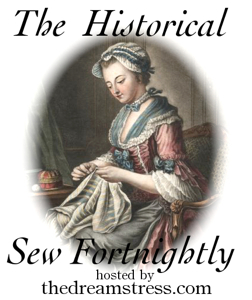I just stumbled upon this cute sewing challenge given by The Dreamstress and I had to join. I'm a bit late in this since it started in January but, well, better late than never. Here's the schedule, given so far, with ** next to the challenges that I am interested in participating in:
** #13: Lace and Lacing - due July 1. Lacing is one of the simplest and oldest forms of fastening a garment, eminently practical, and occasionally decorative. Lace has been one of the most valuable and desirable textiles for centuries, legislated, coveted, at times worth more than its weight in gold, passed down from one garment to the next over centuries. Elaborate and delicate it is eminently decorative, and rarely practical. Celebrate the practicality of lacing, and the decorative frivolity of lace, with a garment that laces or has lace trim, or both. (I would have loved to take part in this one but I didn't have enough time to really think about it before the deadline.)
#14: Eastern Influence – due July 15. The East has had a profound influence on Western fashions for millenia, from the Chinese silks that were worn in Ancient Rome, through the trade in Indian chintzes from the 17th century onward, 18th century chinoiserie, Kashmiri shawls and paisley, 19th century Japonisme, and early 20th century Orientalism and Egyptian revival. In this challenge make an item that shows the Eastern influence on Western fashion.
** #15: Colour Challenge White - due July 29. White has carried many connotations as a colour, from defining culture and social boundaries, to denoting status, to implying purity, or simply cleanliness. For this challenge ‘white’ is defined as anything in the white family – from brightest white, through to ivory and cream and all the shades between. Whether you make a simple chemise or an elaborate ballgown, your item should be predominantly white, though it may have touches of other colours. (I will be making my Garden Hat for this challenge)
** #16: Separates - due August 12. Make a non-matching garment which can be paired with other items in your historical wardrobe to extend your outfit choices.
** #17: Robes & Robings - due August 26. Make a robe-shaped garment, from a biblical robe, through a medieval robe, an 18th century banyan, a Regency evening robe, a 19th century wrapper, or an early 20th century kimono. Or, make one of the frocks called robes by modern English speaking fashion historians, such as a robe volante, robe battante, robe à la coer, robe à la française, robe à l’anglaise (+ turques, polonaises, & circassienne), and the 1920s robe de style. Or, make something with robings (read the event page for a description).
** #18: Re-make, Re-use & Re-fashion – due September 9. Sew something that pays homage to the historical idea of re-using, re-making and re-fashioning. Turn one thing into another. Re-fit or re-fashion an old gown into something you would wear again. Re-trim a hat for a new outfit, or re-shape a modern hat to be a historical hat. Re-purpose the fabric from an old garment (your own or a commercial one) into a new garment. (I will be re-making my cotton dress for this)
